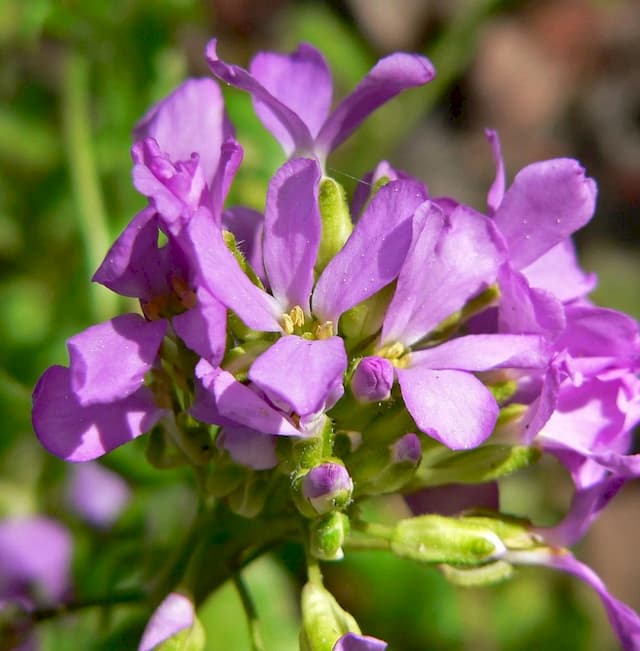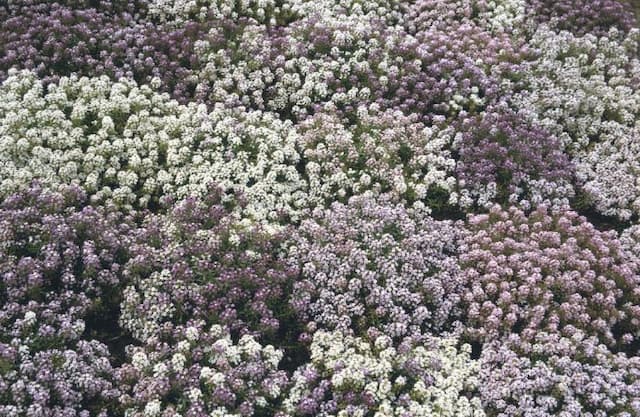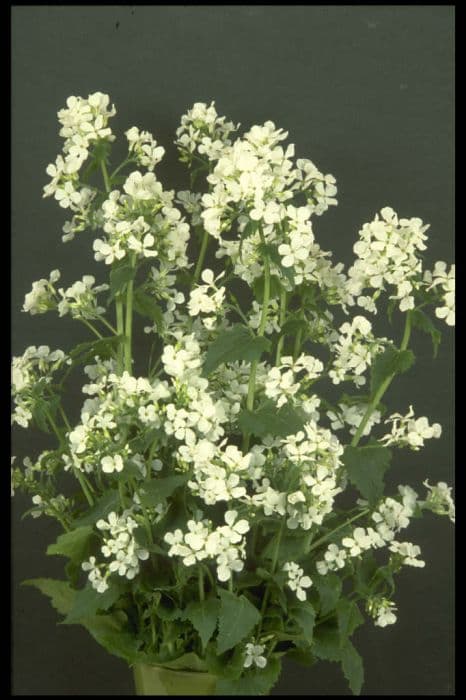Sweet Alyssum Lobularia maritima 'Rosie O'Day'

ABOUT
The Lobularia maritima 'Rosie O'Day', commonly known as Sweet Alyssum, is a charming flowering plant known for its delicate and dainty appearance. This particular cultivar, 'Rosie O'Day', is admired for its profusion of small, vibrant flowers. The blooms boast a rich, deep pink to rose color, which adds a bright pop of color to gardens and containers. These blossoms are tightly clustered together, forming a carpet of color that often appears to spill over the edges of where it is planted. The flowers of Sweet Alyssum are characterized by their four petals, which are arranged in a cross shape, a trait that is typical of the plants in the family to which it belongs. Each petal is slightly rounded, contributing to the flower's overall soft and delicate look. The blooms emit a sweet, honey-like fragrance, which is especially noticeable during the cool hours of early morning and evening, making it a delightful addition to any outdoor area where people might sit and enjoy the scent. Beneath the layers of flowers lie the plant's foliage, which consists of small, narrow leaves. These leaves tend to be a gray-green color and have a slightly fuzzy texture that adds further interest to the plant's appearance. The foliage typically forms a dense mat, which provides a lush backdrop for the bright blooms. Overall, the Sweet Alyssum 'Rosie O'Day' is a captivating plant, valued for its vibrant floral display and sweet fragrance. It adds both color and scent to gardens, borders, pathways, and containers, making it a versatile and attractive choice for gardeners and plant enthusiasts.
About this plant
 Names
NamesFamily
Brassicaceae
Synonyms
Sweet Alyssum, Sweet Alison, Seaside Lobularia
Common names
Alyssum maritimum, Lobularia maritima.
 Toxicity
ToxicityTo humans
Sweet Alyssum is not commonly known to be toxic to humans. There are no major reports of poisoning or adverse symptoms from ingesting parts of the Sweet Alyssum plant. However, as with any plant, individual allergies or sensitivities could cause reactions, and it is generally not recommended to consume ornamental plants.
To pets
Sweet Alyssum is also not considered toxic to pets. It is generally regarded as safe for cats, dogs, and other animals if they happen to ingest small amounts. There should be no symptoms of poisoning from the consumption of Sweet Alyssum. However, consuming any non-food plant can potentially cause mild stomach upset in some pets.
 Characteristics
CharacteristicsLife cycle
Annuals
Foliage type
Evergreen
Color of leaves
Green
Flower color
Pink
Height
6 inches (15 cm)
Spread
1 foot (30 cm)
Plant type
Herb
Hardiness zones
9
Native area
Mediterranean
Benefits
 General Benefits
General Benefits- Easy to grow: Sweet Alyssum 'Rosie O'Day' is known for being a hardy plant that doesn't require much maintenance.
- Attracts pollinators: The plant is attractive to bees, butterflies, and other beneficial insects, promoting biodiversity.
- Drought-tolerant: Once established, Sweet Alyssum can tolerate periods of low water, making it suitable for xeriscaping.
- Ground cover: Its low-growing habit makes it an excellent choice for covering bare spots and suppressing weeds in gardens.
- Edging plant: Used to create neat borders along garden beds, paths, or driveways.
- Continuous blooming: Sweet Alyssum flowers for an extended period from spring to fall, providing long-lasting color.
- Fragrant flowers: The blooms have a light, sweet scent that can be enjoyed when planted in borders or containers near seating areas.
- Container-friendly: Suitable for growing in planters, hanging baskets, and window boxes due to its trailing habit and compact size.
- Versatile color: Adds a splash of color to various garden designs with its vibrant pink flowers.
- Seasonal interest: Offers visual interest throughout the growing season, enhancing the overall appeal of gardens and landscapes.
 Medical Properties
Medical PropertiesThis plant is not used for medical purposes.
 Air-purifying Qualities
Air-purifying QualitiesThis plant is not specifically known for air purifying qualities.
 Other Uses
Other Uses- Alyssum 'Rosie O'Day' can act as a living mulch, covering the soil between other plants, thereby retaining soil moisture and controlling weeds.
- The dense growth habit of alyssum can be used in rock gardens to soften edges and fill gaps between stones, providing a cascading effect.
- This plant can be employed as a natural pest deterrent, with its fragrant flowers possibly helping to ward off certain undesirable insects.
- Alyssum's mat-forming characteristic makes it ideal for use in green roofing, contributing to biodiversity and insulation.
- Due to its low-growing nature, alyssum can be planted along walkways or paths to create fragrant, flowering borders that require minimal maintenance.
- The plant can serve as a ground cover in butterfly gardens, as it attracts a variety of pollinators with its nectar-rich blooms.
- When used as an edging plant, alyssum can define garden beds and give structure to landscaping designs.
- The flowers of alyssum can be used to add a decorative touch to salads and desserts when used as an edible garnish, as long as they haven't been treated with pesticides.
- Alyssum can be planted in hanging baskets to create a spill-over effect with its abundant, colorful blooms, adding visual appeal to balconies and patios.
- In mild climates, alyssum can serve as a perennial ground cover, reducing the need for seasonal replanting and providing year-round garden interest.
Interesting Facts
 Feng Shui
Feng ShuiSweet Alyssum is not used in Feng Shui practice.
 Zodiac Sign Compitability
Zodiac Sign CompitabilitySweet Alyssum is not used in astrology practice.
 Plant Symbolism
Plant Symbolism- Innocence: Lobularia maritima, commonly known as sweet alyssum, has delicate small flowers which often symbolize innocence and purity.
- Beauty: The dainty and clustered appearance of the sweet alyssum's blossoms are emblematic of beauty and aesthetic appeal.
- Protection: Historically, sweet alyssum was believed to offer protection against evil and bad luck when planted around homes and in gardens.
- Calming Tranquility: The sweet alyssum's gentle fragrance and soft petals are often associated with peace and calm, suggesting a serene environment.
- Healing: Due to its use in traditional medicine for various ailments, sweet alyssum can symbolize healing and restoration of health.
 Water
WaterSweet Alyssum should be watered regularly to keep the soil moist but not waterlogged. Young plants need more frequent watering, generally about 1 inch of water per week, either from rainfall or manual watering. In hot, dry periods, watering may need to increase to twice a week. When watering, aim the water at the base of the plant to avoid getting the foliage wet, which can lead to disease. It's essential not to overwater, as this can cause root rot; a good rule of thumb is to water when the top inch of soil feels dry to the touch.
 Light
LightSweet Alyssum thrives in full sun to partial shade. The ideal spot would offer at least 6 hours of direct sunlight per day, although it can tolerate some light afternoon shade, especially in hotter climates. Avoid deep shade as it will lead to poor blooming and a leggy growth habit.
 Temperature
TemperatureSweet Alyssum prefers moderate temperatures and will grow best when daytime temperatures are between 60°F and 75°F. It can withstand minimum temperatures down to 40°F, making it a good choice for early spring and fall. However, it does not tolerate extreme heat well, and temperatures consistently above 85°F may hinder its growth and flowering.
 Pruning
PruningPrune Sweet Alyssum to encourage bushier growth and more blooms. After the first flush of flowers fades, cut the plants back by one-third to stimulate a second bloom period. It is best to prune in the late spring or early summer, after the risk of frost has passed but before the high heat of midsummer. Regularly deadheading spent flowers can also promote continuous blooming throughout the season.
 Cleaning
CleaningAs needed
 Soil
SoilSweet Alyssum prefers well-draining soil with a neutral to slightly alkaline pH, ranging from 6.5 to 7.5. A mix of garden soil, peat, and perlite or sand works well to ensure proper drainage and aeration. Adding compost or well-rotted manure can improve soil fertility and structure.
 Repotting
RepottingSweet Alyssum is typically grown as an annual and does not usually require repotting. If grown as a perennial in warm climates, repot every two to three years to refresh the soil and encourage healthy growth.
 Humidity & Misting
Humidity & MistingSweet Alyssum is tolerant of a range of humidity levels but thrives best in moderate conditions. It does not require high humidity; ambient moisture levels are usually sufficient for healthy growth.
 Suitable locations
Suitable locationsIndoor
Provide full sun, well-draining soil, and water regularly.
Outdoor
Plant in full sun, well-drained soil, water as needed.
Hardiness zone
7-10 USDA
 Life cycle
Life cycleLobularia maritima 'Rosie O'Day', commonly known as Sweet Alyssum 'Rosie O'Day', begins its life cycle when its small, black seeds germinate in warm, moist soil. Seedlings emerge within 7-14 days, where they establish a rosette of leaves at the soil surface. As the plant matures, it develops a mass of small, ovate leaves and begins to form dense clusters of tiny, fragrant pink to rose-colored flowers that bloom from late spring through fall. Throughout the blooming period, the plant is capable of self-sowing, thereby producing new seeds that can germinate to create new plants. After the flowering season, the plant enters senescence, with foliage and flowers fading, followed by the plant eventually dying. In some climates, however, Sweet Alyssum 'Rosie O'Day' behaves as a self-seeding annual, completing its life cycle within one year and regrowing the following season from the seeds produced previously.
 Propogation
PropogationPropogation time
Spring to Summer
The most popular method for propagating Sweet Alyssum 'Rosie O'Day' is through seed. The seeds can be sown directly into the garden after the last frost when the soil temperature has warmed up, as this plant is sensitive to cold. For an earlier start, you can sow seeds indoors 6 to 8 weeks before the last expected frost using a seed starting mix. Lightly press the seeds into the soil as they need light for germination, and keep the soil moist but not saturated. The seeds typically germinate within 7 to 14 days at a temperature of around 70 degrees Fahrenheit (about 21 degrees Celsius). Once seedlings have developed a couple of true leaves and have grown strong enough to handle the elements, they can be transplanted outdoors into their final growing positions, spaced about 6 to 9 inches (15 to 23 centimeters) apart to allow for proper airflow and growth.


![Aubrieta [Axcent Lilac]](/_next/image?url=https%3A%2F%2Fplants-admin.emdemapps.com%2Fimages%2Fplants%2F%2Fimages%2F604b5e2430fac.png&w=640&q=75)






